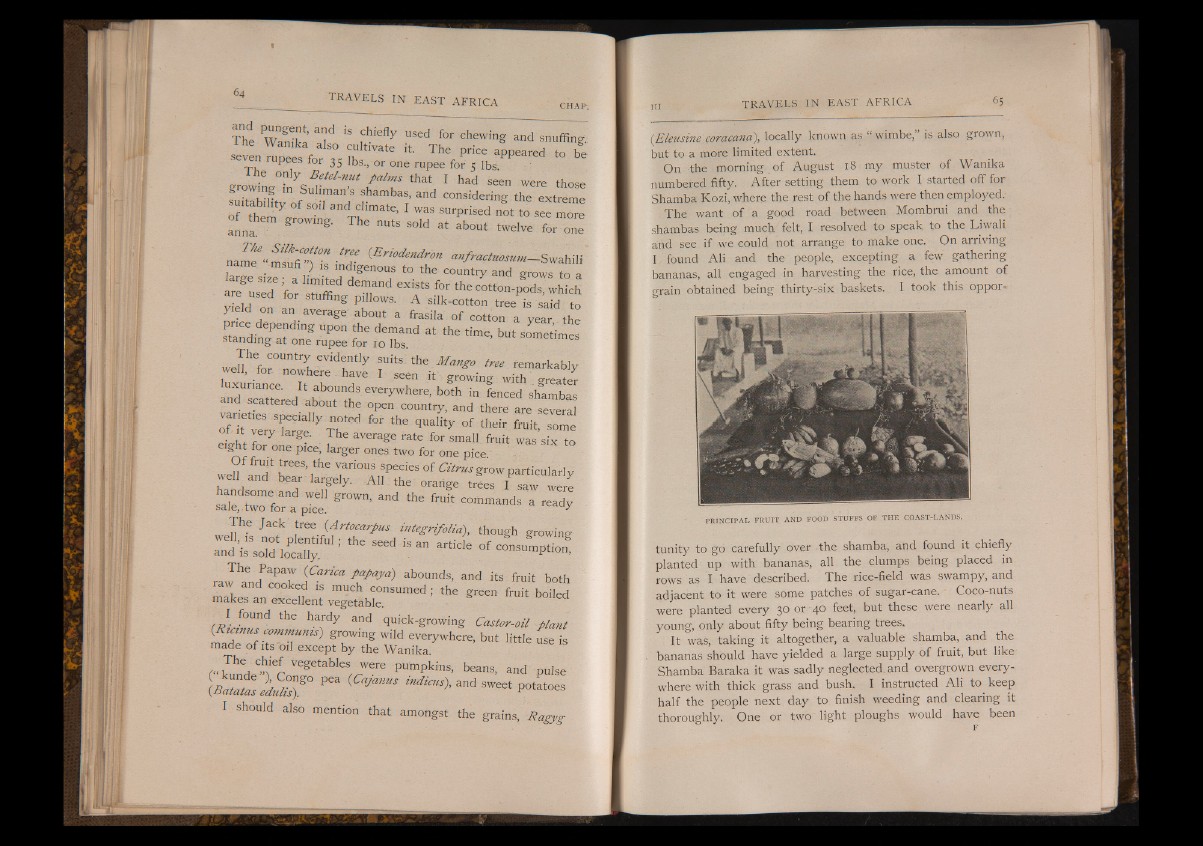
The Wanika 'I USCd {°T chewinS Wanika also cultivate it. The price appaenadre dsn utfofi nbge..
seven rupees for 35 lbs., or one rupee for 5 lbs.
he only Betel-nut palms that I had seen were those
Z Z ' i r r J f amb“ ' and “ »»dering the extreme
nf Hi 3n Chmate’ 1 was surprised not to see more
anna ^ S°H 4 ab»“ ‘ * » * *
namc^“ rn fm f" fT ' wrfk (-Brwdindr,m mfracmosum— SwahiM
name _ mSufig is indigenous to the country and grows to a
rge size; a limited demand exists for the cotton-pods which
are used for stuffing pillows. A silk-cotton tree is saTd to
yield on an average about a frasila of cotton a year the
price depending upon the demand at the time, but sometimes
standing at one rupee for 10 lbs.
we™ for° n™yt, eiidf tly I " “ * ' he M‘‘ ng0 remarkably
h i » c e S X T “ mowing with greatei
luxuriance. It abounds everywhere, both in fenced shambas
an scattered about the open country, and there are several
varieties specially noted for the quality of their fruit, some
eeiigghhtt ffoorr oonnper pgiec‘ e, Hlargie r ones twSo ifo ■r on Sem pa1ic1 e.fruit Was six to
Of fruit trees, the various species of Citrus grow particularly
well and bear largely. All , he orange j S g X j g
handsome and well grown, and the fruit commands a ready
sale,.two for a pice. y
The Jack'tree {Artocarpus mtegrifolia), though growing
an d re so ld locally ’ «<* o f consumption.
The Papaw {Carica papaya) abounds, and its fruit both
raw and cooked is much consumed; the green fruit boiled
makes an excellent vegetable.
(f}. f°Und the hardP and quick-growing Castor-oil plant
{Rtcimts communis) growing wild everywhere, but little use is
made of its oil except by the Wanika.
f‘‘ l f u n V ^ r o VegetableV Were p um P kins> bean*, an d p u lse
y S Z S S R ? * - (C V am S an d sweet p o ta to e s
I Should also mention that amongst the grains, Ragyg
(Eleusine coracana), locally known as “ wimbe, is also grown,
but to a more limited extent.
On the morning of August 18 my muster of Wanika
numbered fifty. After setting them to work I started off for
Shamba Kozi, where the rest of the hands were then employed.
The want of a good road between Mombrui and the
shambas being much felt, I resolved to speak to the Liwali
and see if we could not arrange to make one. On arriving
I. found Ali and the people, excepting a few gathering
bananas, all engaged in harvesting the rice, the amount of
grain obtained being thirty ^six baskets. I took this oppor-
PRINCIPAL FRUIT AND FOOD STUFFS OF THE COAST-LANDS.
tunity to go carefully over the shamba, and found it chiefly
planted up with bananas, all the clumps being placed in
rows as I have described. The rice-field was swampy, and
adjacent to it were some patches of sugar-cane. Coco-nuts
were planted every 30 or 40 feet, but these were nearly all
young, only about fifty being bearing trees.
It was, taking it altogether, a valuable shamba, and the
bananas should have yielded a large supply of fruit, but like
Shamba Baraka it was sadly neglected, and overgrown everywhere
with thick grass and bush. I instructed Ali to keep
half the people next day to finish weeding and clearing it
thoroughly. One or two light ploughs would have been